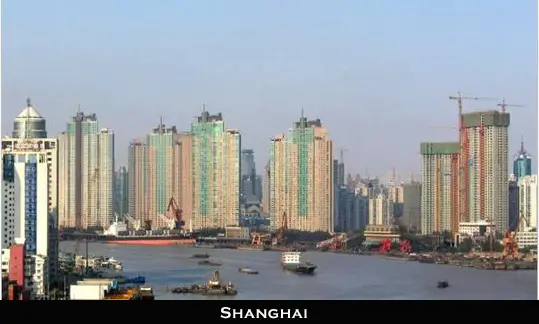China and Climate Change… This country ranges from mostly plateaus and mountains in the west to lower lands in the east. Principal rivers flow from west to east, including the Yangtze (central), the Huang He (Yellow river, north-central), and the Amur (northeast), and sometimes toward the south (including the Pearl River, Mekong River, and Brahmaputra), with most Chinese rivers emptying into the Pacific Ocean.
In the west, the north has a great alluvial plain, and the south has a vast calcareous tableland traversed by hill ranges of moderate elevation, and the Himalayas, containing Earth’s highest point, Mount Everest. The northwest also has high plateaus with more arid desert landscapes such as the Takla-Makan and the Gobi Desert, which is expanding.

Population
According to the Beijing News (Nov 2007) and citing Zhai Zhenwu, head of a population research institute at the People’s University in Beijing, China’s population which now stands at 1.3 billion, will reach 1.45 to 1.46 billion by 2020, before peaking at 1.5 billion in 2033. “Currently, China is adding 16 million people a year. By 2012, annual (population increase) will reach a peak of 19 million,” the Beijing News quoted Zhai as saying. The current population density in Guangdong is 466 people per square kilometre (sqkm)and in Chongqing it is a staggering 789.
With the world’s biggest population straining scarce land, water and energy resources, China has enforced rules to restrict family size since the 1970s. Rules vary but usually limit families to one child, or two in the countryside.
China says its policies have prevented several hundred million births and boosted prosperity, but experts have warned of a looming social time-bomb from an ageing population and widening gender disparity stemming from a traditional preference for boys.
Economy
China is slightly smaller in land size than the United States, although it holds one fifth of the world’s population. China’s economy during the last quarter century has changed from a centrally planned system that was largely closed to international trade to a more market-oriented economy that has a rapidly growing private sector and is a major player in the global economy. The past two decades, China’s economy has grown at an average annual rate of more than 8%.
The economic boom has an environmental dark side for China and climate change. While China’s economy continues to grow at a rate of more than 8% annually, as it has for more than two decades, the country’s environment and the Chinese people are paying a steep price. China now boasts five of the ten most polluted cities in the world; 70% of the water that flows through China’s urban areas is unfit for drinking or fishing; and severely degraded land or desert, which now claims 1/4 of China’s land, is advancing at a rate of 1300 sq. miles per year.
Coal and Energy Consumption
When thinking about China and climate change, alarms are ringing, as it is the largest coal producer and consumer of these fossil fuels in the world, with coal representing some 70% of total primary energy consumption. There is a heavy reliance on oil imports which was around 46% in 2007 and rising fast, however there is significant use of cleaner liquid natural gas.
The very high use of coal gives rise to major environmental concerns due to low energy utilisation efficiency and inadequate pollution control, especially of dust and SO2, while emissions of carbon dioxide have increased markedly over the past twenty years. This high dependency on coal does not bode well for China and climate change, or indeed our planet.
China and Climate Change – Kyoto Protocol
Along with India, China is exempt from the requirements of the Kyoto Protocol,the agreement that calls on industrial nations to reduce emissions by 2012. (The United States and initially Australia did not sign the agreement). However, China joined nearly 190 nations in Bali in December 2007 in agreeing to launch two years of UN-led talks to create a global emissions-fighting pact to replace Kyoto from 2013.
China and Climate Change – Consequences
Recently, a government spokesperson for China said that wealthier, developed countries must take the lead in curbing greenhouse gas emissions and declined to say whether it would agree to any mandatory emissions limits that might hamper its booming economy.
The first government national assessment of China and climate change completed in 2006, predicted that precipitation will also increase drastically in the coming decades, rising up to 17 percent by the turn of the next century. However, this will bring little or no relief to China’s frequently drought-stricken farmers, as even though overall more rainfall is expected, water shortages will increase because of faster evaporation caused by higher temperatures. Drought,heat waves and other extreme weather will also hit China more often. More about how rainfall and water quality are measured.

Much of northern China has been gripped by a brutal drought and State media reported that roughly 300,000 people in Shaanxi Province were facing shortages of drinking water. The province has received only 10 percent of its average rainfall, according to Xinhua, the state-run press agency.
A railway that opened in 2006, linking remote Tibet to provinces further east will be affected as part of the rail is built on top of subsoil that maintains sub-zero temperatures throughout the year but may start to thaw due to hotter weather and will threaten the system. Glaciers in the nation’s northwest have decreased by 21 percent since the 1950s, and all China’s major rivers have shrunk over the past five decades.
China and Climate Change – Actions
China is the world’s second biggest emitter of greenhouse gases, but has promised to more than double its reliance on renewable energy by 2020, which could make it a leading player in the wind, solar and hydro power industries. Statistics show that in 2005, a total of US$38 billion was invested in renewable energy development worldwide. China topped the list with a commitment of US$6 billion, excluding spending on large hydro power projects.
China’s renewable energy development is guaranteed under the nation’s first Renewable Energy Law, which came into force on January 1 2006. In February, the government issued a set of rules to implement the law. In addition, officials have decided to raise the rate for electricity consumption by 0.025 yuan per kilowatt-hour ($0.32 cents/kWh), a small fraction of which (0.001yuan/kWh, or $0.013 cents/kWh) is being collected for the development of renewable energy. Early in October 2006, the Ministry of Finance released details of a new fund dedicated to the development of renewable energy sources, which will use grants and interest subsidies to give government support to renewables’ development in three main areas: oil alternatives, construction, and power generation.
One of the weakness in the past in deploying renewable energy was the lack of independent technology development. Much of the renewable equipment and technology being used, whether for wind power, biomass, or solar , has been imported, resulting in higher production and consumption costs. Western leaders have not had the vision to appreciate this obvious point, and to some extent bear responsibility for China’s whole hearted technological adoption of dirty coal fuel as sources for power generation.
However China is becoming a leader in renewable energy, particulary in wind power. The 11th 5 Year Plan set a wind turbine target of 5GW capacity by 2010, and 30GW by 2020. It is reported that by the end of 2007 installed capacity was at 6.5GW with another 4.2 GW under construction. Another recent report shows total installed capacity will reach 120 GW by 2020, which is four times that planned.
The manufacturing of photovoltaic cells for solar panels is growing very fast as an industry, but ninety percent of the cells are exported and only a very small amount is actually installed in China. Solar installation in China are pretty much limited to hot water systems.
In terms of renewable energy from biomass, this sector is also growing fast especially in farm and rural settings. It is reported that 22 million homes used methane capturing in 2006, and about 30 million homes were supplied by this fuel source at the end of 2007. A few biomass gasification power stations exist fuelled by sugarcane, agricultural and forest waste. Liquid biofuels in the form ofethanol reached 850,000 tonnes 2007 with 400,000 tonnes of biodiesel produced in 2007.
China and Climate Change – Efficiency Measures
China and climate change couldn’t be spoken about with referring to its focus on energy efficiency. This area is now high priority and incorporated into national policy. The focus is necessary as energy consumption per building area is two-to-three times that of developed countries and energy efficiency generally is a lot lower than other advanced countries. In the big industry sectors like: steel making; power generation; and cement the industries consume 20% more energy than the average of developed counties.
A raft of new measures such as the Energy Saving Law that came into effect April 2008 plus compulsory energy standards for some manufacturing industries will assist China in becoming more energy efficient. New buildings also have mandatory building efficiency standards, incorporating energy saving materials and integration of renewable energy systems.
While this page is headed up, ‘China and Climate Change’, it is of course a global problem. Development and deployment of renewable energy across the globe is now critical if we are going to avoid catastrophic consequences of climate change in the decades ahead.
